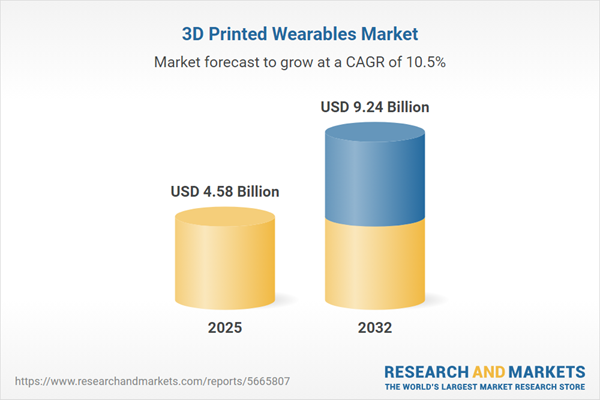Speak directly to the analyst to clarify any post sales queries you may have.
The 3D printed wearables market is rapidly evolving, driven by demand for personalization, seamless device integration, and advances in additive manufacturing that enable cost-effective, agile product development. Organizations seeking to remain competitive must stay ahead of these intersecting technology and consumer trends.
Market Snapshot: Key Metrics and Growth in 3D Printed Wearables
The 3D printed wearables market grew from USD 4.15 billion in 2024 to USD 4.58 billion in 2025 and is projected to reach USD 9.24 billion by 2032. Strong compound annual growth of 10.52% reflects expanding applications and accelerated adoption across industries. The market is influenced by the rising demand for hyper-customized products, adoption across healthcare, defense, automotive, and consumer sectors, and substantial regional investments in additive manufacturing infrastructure.
Scope & Segmentation of the 3D Printed Wearables Market
- Product Type: AR glasses (consumer, enterprise, healthcare), fitness bands, medical implants (cardiovascular, dental, orthopedic), smart jewelry, smart textiles (conductive yarns, e-textiles, sensor-embedded fabrics), and smart watches.
- Technology: DMLS, FDM, inkjet printing, SLA (digital light processing, continuous liquid interface production), SLS (binder jetting, laser sintering).
- Material: Ceramics, composites (carbon fiber reinforced, glass fiber reinforced), metals (aluminum, stainless steel, titanium), and polymers (ABS, nylon, PLA).
- End User: Aerospace defense, automotive, consumer electronics (smartphones, wearable devices), healthcare (clinics, home care, hospitals), sports and fitness sectors.
- Application: Communication (gesture control, haptic feedback), entertainment (gaming wearables, virtual reality), fitness monitoring, health monitoring (diagnostic, vital signs), industrial uses.
- Distribution Channel: Offline retail (retail chains, specialty stores), online (manufacturer direct, third-party ecommerce).
- Regional Coverage: Americas (North America: United States, Canada, Mexico; Latin America: Brazil, Argentina, Chile, Colombia, Peru), Europe, Middle East & Africa (major European, Middle Eastern, and African markets), Asia-Pacific (China, India, Japan, Australia, South Korea, Indonesia, Thailand, Malaysia, Singapore, Taiwan).
- Companies Analyzed: Stratasys Ltd., 3D Systems, Inc., Materialise NV, EOS GmbH Electro Optical Systems, HP Inc., Carbon, Inc., Desktop Metal, Inc., EnvisionTEC GmbH, Prodways Group SA, SLM Solutions Group AG.
Key Takeaways for Senior Decision-Makers
- Customization is now possible even in mass production environments, allowing companies to develop wearables tailored to individual ergonomics and specific industry needs.
- Innovation in material science and digital workflows is producing lightweight, durable wearable devices with embedded electronics and advanced sensing capabilities.
- Augmented reality, haptic feedback, and sensor-embedded textiles are expanding the potential of smart wearables beyond traditional wellness, now supporting enterprise, medical, and industrial functions.
- Segment growth is influenced by the adoption of new production technologies and integration with cloud-based software, leading to higher value smart products.
- Regional trends reflect increased investment in research, infrastructure, and localized manufacturing, creating vibrant innovation ecosystems in North America, Europe, the Middle East, Africa, and Asia-Pacific.
Tariff Impact on 3D Printed Wearables
Tariffs enacted in the United States in 2025 have influenced strategic supply chain decisions across the 3D printed wearables domain. Manufacturers are increasingly establishing local production facilities to mitigate tariff and logistics risks and are diversifying materials sourcing to preserve margins by avoiding high-tariff categories. Procurement strategies are adjusting to emphasize landed cost transparency and risk management, especially for polymers and specialized metals used in wearable devices.
Methodology & Data Sources
This research leverages a multidisciplinary framework integrating primary interviews with senior executives, R&D leaders, and supply chain specialists across relevant geographies. Secondary sources include peer-reviewed journals, technical white papers, and patent analysis. A rigorous process of data triangulation, scenario planning, and expert panel review ensures reliability and actionable insights throughout the report.
Why This Report Matters for B2B Stakeholders
- Gain a comprehensive understanding of key market segments, technology trajectories, and regional adoption patterns that directly impact strategic planning and investment outcomes.
- Leverage actionable guidance to optimize sourcing, procurement, and production strategies in response to shifting regulatory and competitive dynamics.
- Identify significant opportunities for cross-industry partnerships and technology-driven differentiation in a rapidly changing innovation landscape.
Conclusion
The 3D printed wearables market presents strong opportunities for growth and disruption across multiple industries. As customization and smart integration become standard, those poised to adapt and innovate will lead the next phase of expansion. Strategic planning and cross-functional collaboration are key to unlock long-term value.
Additional Product Information:
- Purchase of this report includes 1 year online access with quarterly updates.
- This report can be updated on request. Please contact our Customer Experience team using the Ask a Question widget on our website.
Table of Contents
3. Executive Summary
4. Market Overview
7. Cumulative Impact of Artificial Intelligence 2025
Companies Mentioned
The companies profiled in this 3D Printed Wearables market report include:- Stratasys Ltd.
- 3D Systems, Inc.
- Materialise NV
- EOS GmbH Electro Optical Systems
- HP Inc.
- Carbon, Inc.
- Desktop Metal, Inc.
- EnvisionTEC GmbH
- Prodways Group SA
- SLM Solutions Group AG
Table Information
| Report Attribute | Details |
|---|---|
| No. of Pages | 199 |
| Published | October 2025 |
| Forecast Period | 2025 - 2032 |
| Estimated Market Value ( USD | $ 4.58 Billion |
| Forecasted Market Value ( USD | $ 9.24 Billion |
| Compound Annual Growth Rate | 10.5% |
| Regions Covered | Global |
| No. of Companies Mentioned | 11 |









